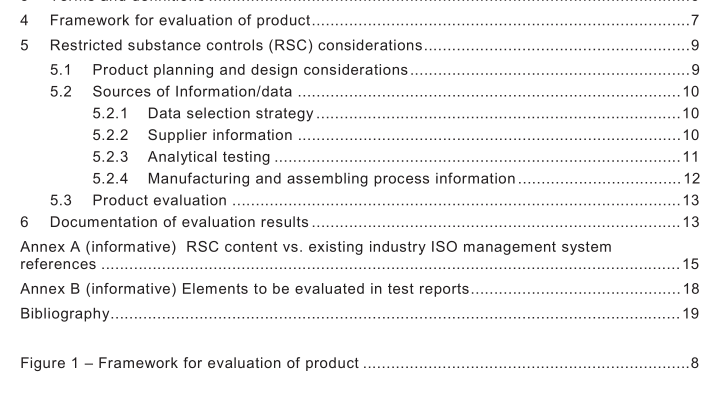PD IEC TR 62476:2010 pdf download – Guidance for evaluation of products with respect to substance-use restrictions in electrical and electronic products
Each producer in the supply chain is responsible for defining his own evaluation methods for each product or product category. The identification of products included in a product category is the responsibility of the producer based on his knowledge of the product line.
RSC is specific to a producer. It may be part of an established quality management system (e.g. ISO 9001 ) or environmental management system (e.g. ISO 1 4001 ) or equivalent management system. It may also be an independent set of documented procedures and their records. A producer relying on outsourced manufacturing needs to ensure that their outsourced manufacturing operations also have effective RSC.
Annex A provides examples of RSC requirements in relation to internationally recognized management systems. The application of evaluation strategies and methods can be unique for every product, but such strategies should be based on the producer’s policy, product planning and design and technical documentation. Therefore, the selection or definition of evaluation methods for product materials, parts and/or sub-assemblies should be based on the producer’s experience or technical judgment of the likelihood that a restricted substance may be present in either the supply chain or in internal product operations. Finally, in order to declare that the requirements are met, the producer can provide a “producer self-declaration”. If further information is needed, technical documentation can be provided.
5 Restricted substance controls (RSC) considerations
5.1 Product planning and design considerations
The producer top management should ensure that a documented strategy on the control of restricted substances is defined and appropriate for the purpose of the organization. A producer’s RSC strategy may be detailed and targeted towards specific product lines or specific environmental regulations, or more general and broader to cover multiple product lines and operations in multiple geographical areas covering multiple environmental regulations, as appropriate to the organization.
As a first step, it is important to develop a list of restricted substances. Documented evaluation methods for different types of materials based on common knowledge or expert competence should be in place for the producer and its suppliers. There should be evidence that procedures are being followed and that materials declarations or other types of technical documentation have been assessed to confirm completeness and accuracy.
A framework for evaluation of a product may lever an environmentally conscious design (ECD) process such as defined by IEC 62430 and as it relates to substance use restrictions. For example, the IEC 62430 standard specifies that the ECD process includes defined steps such as:
a) analysis of the regulatory and stakeholders’ environmental requirements;
b) identification and evaluation of environmental aspects and corresponding impacts;
c) product planning, design and development;
d) review and continual improvement;
e) sharing ECD information in the supply chain.
At the product planning and design stage, the following information should be available:
• restricted substance requirements (regulatory, customer or other requirements);
• those aspects that have, or can have, significant impacts on the restricted substance content in products during manufacturing or assembly;
• identification of product categories;
• definition of organizational systems, roles and responsibilities for implementation of RSC;
• appropriate specification from planning and design functions to give appropriate inputs to the procurement functions with regard to supplier RSC;
• confirmation of an effective process for the evaluation and selection of parts and materials;
• a review of operational process requirements (e.g. lead and lead-free process line segregation).
NOTE Annex A provides complementary guidance.
5.2 Sources of information/data
5.2.1 Data selection strategy
To ensure cost-effective flow of information, the producer should determine the likelihood of restricted substances being present for every material, part and sub-assembly included in the product.PD IEC TR 62476 pdf download.
